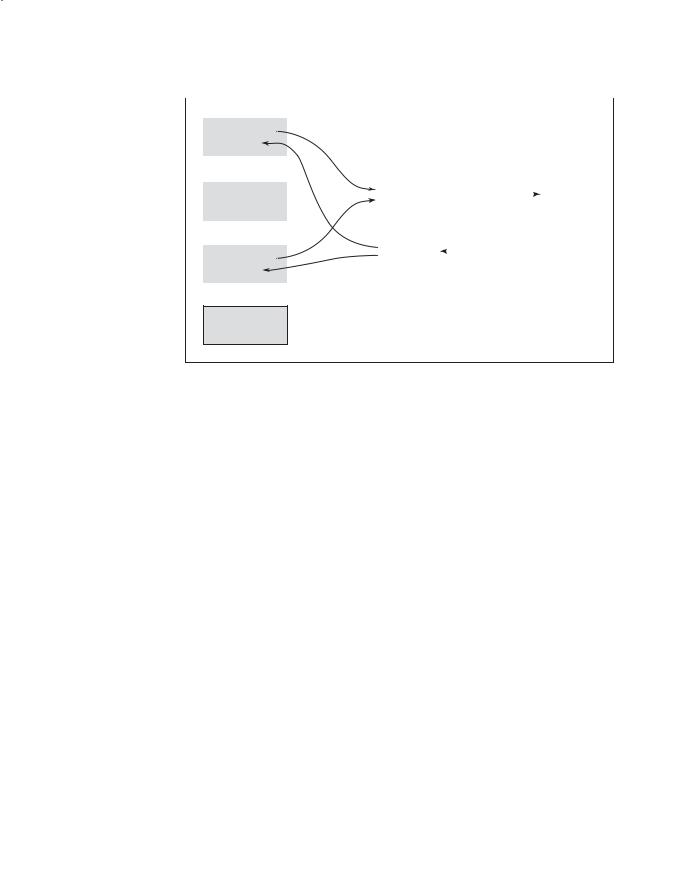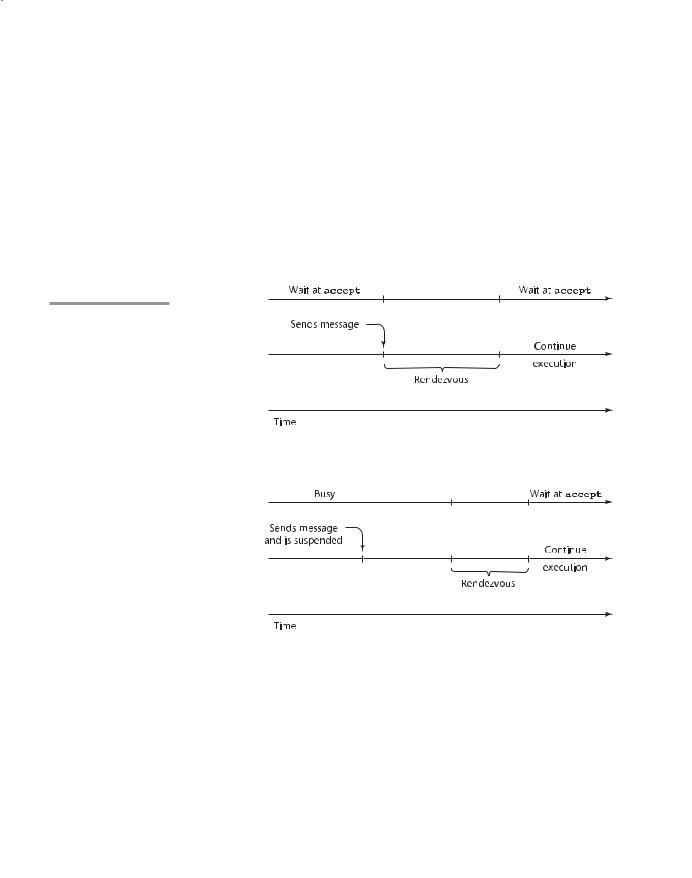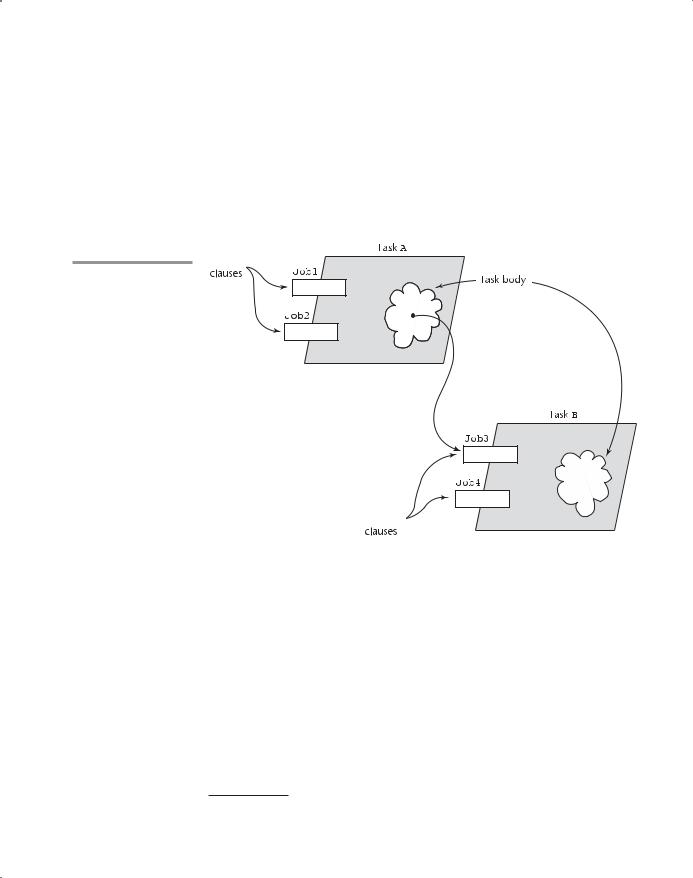
- •New to the Tenth Edition
- •Preface
- •Acknowledgments
- •About the Author
- •Contents
- •1.1 Reasons for Studying Concepts of Programming Languages
- •1.2 Programming Domains
- •1.3 Language Evaluation Criteria
- •1.4 Influences on Language Design
- •1.5 Language Categories
- •1.6 Language Design Trade-Offs
- •1.7 Implementation Methods
- •1.8 Programming Environments
- •Summary
- •Problem Set
- •2.1 Zuse’s Plankalkül
- •2.2 Pseudocodes
- •2.3 The IBM 704 and Fortran
- •2.4 Functional Programming: LISP
- •2.5 The First Step Toward Sophistication: ALGOL 60
- •2.6 Computerizing Business Records: COBOL
- •2.7 The Beginnings of Timesharing: BASIC
- •2.8 Everything for Everybody: PL/I
- •2.9 Two Early Dynamic Languages: APL and SNOBOL
- •2.10 The Beginnings of Data Abstraction: SIMULA 67
- •2.11 Orthogonal Design: ALGOL 68
- •2.12 Some Early Descendants of the ALGOLs
- •2.13 Programming Based on Logic: Prolog
- •2.14 History’s Largest Design Effort: Ada
- •2.15 Object-Oriented Programming: Smalltalk
- •2.16 Combining Imperative and Object-Oriented Features: C++
- •2.17 An Imperative-Based Object-Oriented Language: Java
- •2.18 Scripting Languages
- •2.19 The Flagship .NET Language: C#
- •2.20 Markup/Programming Hybrid Languages
- •Review Questions
- •Problem Set
- •Programming Exercises
- •3.1 Introduction
- •3.2 The General Problem of Describing Syntax
- •3.3 Formal Methods of Describing Syntax
- •3.4 Attribute Grammars
- •3.5 Describing the Meanings of Programs: Dynamic Semantics
- •Bibliographic Notes
- •Problem Set
- •4.1 Introduction
- •4.2 Lexical Analysis
- •4.3 The Parsing Problem
- •4.4 Recursive-Descent Parsing
- •4.5 Bottom-Up Parsing
- •Summary
- •Review Questions
- •Programming Exercises
- •5.1 Introduction
- •5.2 Names
- •5.3 Variables
- •5.4 The Concept of Binding
- •5.5 Scope
- •5.6 Scope and Lifetime
- •5.7 Referencing Environments
- •5.8 Named Constants
- •Review Questions
- •6.1 Introduction
- •6.2 Primitive Data Types
- •6.3 Character String Types
- •6.4 User-Defined Ordinal Types
- •6.5 Array Types
- •6.6 Associative Arrays
- •6.7 Record Types
- •6.8 Tuple Types
- •6.9 List Types
- •6.10 Union Types
- •6.11 Pointer and Reference Types
- •6.12 Type Checking
- •6.13 Strong Typing
- •6.14 Type Equivalence
- •6.15 Theory and Data Types
- •Bibliographic Notes
- •Programming Exercises
- •7.1 Introduction
- •7.2 Arithmetic Expressions
- •7.3 Overloaded Operators
- •7.4 Type Conversions
- •7.5 Relational and Boolean Expressions
- •7.6 Short-Circuit Evaluation
- •7.7 Assignment Statements
- •7.8 Mixed-Mode Assignment
- •Summary
- •Problem Set
- •Programming Exercises
- •8.1 Introduction
- •8.2 Selection Statements
- •8.3 Iterative Statements
- •8.4 Unconditional Branching
- •8.5 Guarded Commands
- •8.6 Conclusions
- •Programming Exercises
- •9.1 Introduction
- •9.2 Fundamentals of Subprograms
- •9.3 Design Issues for Subprograms
- •9.4 Local Referencing Environments
- •9.5 Parameter-Passing Methods
- •9.6 Parameters That Are Subprograms
- •9.7 Calling Subprograms Indirectly
- •9.8 Overloaded Subprograms
- •9.9 Generic Subprograms
- •9.10 Design Issues for Functions
- •9.11 User-Defined Overloaded Operators
- •9.12 Closures
- •9.13 Coroutines
- •Summary
- •Programming Exercises
- •10.1 The General Semantics of Calls and Returns
- •10.2 Implementing “Simple” Subprograms
- •10.3 Implementing Subprograms with Stack-Dynamic Local Variables
- •10.4 Nested Subprograms
- •10.5 Blocks
- •10.6 Implementing Dynamic Scoping
- •Problem Set
- •Programming Exercises
- •11.1 The Concept of Abstraction
- •11.2 Introduction to Data Abstraction
- •11.3 Design Issues for Abstract Data Types
- •11.4 Language Examples
- •11.5 Parameterized Abstract Data Types
- •11.6 Encapsulation Constructs
- •11.7 Naming Encapsulations
- •Summary
- •Review Questions
- •Programming Exercises
- •12.1 Introduction
- •12.2 Object-Oriented Programming
- •12.3 Design Issues for Object-Oriented Languages
- •12.4 Support for Object-Oriented Programming in Smalltalk
- •12.5 Support for Object-Oriented Programming in C++
- •12.6 Support for Object-Oriented Programming in Objective-C
- •12.7 Support for Object-Oriented Programming in Java
- •12.8 Support for Object-Oriented Programming in C#
- •12.9 Support for Object-Oriented Programming in Ada 95
- •12.10 Support for Object-Oriented Programming in Ruby
- •12.11 Implementation of Object-Oriented Constructs
- •Summary
- •Programming Exercises
- •13.1 Introduction
- •13.2 Introduction to Subprogram-Level Concurrency
- •13.3 Semaphores
- •13.4 Monitors
- •13.5 Message Passing
- •13.6 Ada Support for Concurrency
- •13.7 Java Threads
- •13.8 C# Threads
- •13.9 Concurrency in Functional Languages
- •13.10 Statement-Level Concurrency
- •Summary
- •Review Questions
- •Problem Set
- •14.1 Introduction to Exception Handling
- •14.2 Exception Handling in Ada
- •14.3 Exception Handling in C++
- •14.4 Exception Handling in Java
- •14.5 Introduction to Event Handling
- •14.6 Event Handling with Java
- •14.7 Event Handling in C#
- •Review Questions
- •Problem Set
- •15.1 Introduction
- •15.2 Mathematical Functions
- •15.3 Fundamentals of Functional Programming Languages
- •15.4 The First Functional Programming Language: LISP
- •15.5 An Introduction to Scheme
- •15.6 Common LISP
- •15.8 Haskell
- •15.10 Support for Functional Programming in Primarily Imperative Languages
- •15.11 A Comparison of Functional and Imperative Languages
- •Review Questions
- •Problem Set
- •16.1 Introduction
- •16.2 A Brief Introduction to Predicate Calculus
- •16.3 Predicate Calculus and Proving Theorems
- •16.4 An Overview of Logic Programming
- •16.5 The Origins of Prolog
- •16.6 The Basic Elements of Prolog
- •16.7 Deficiencies of Prolog
- •16.8 Applications of Logic Programming
- •Review Questions
- •Programming Exercises
- •Bibliography
- •Index

13.4 Monitors |
591 |
13.4 Monitors
One solution to some of the problems of semaphores in a concurrent environment is to encapsulate shared data structures with their operations and hide their representations—that is, to make shared data structures abstract data types with some special restrictions. This solution can provide competition synchronization without semaphores by transferring responsibility for synchronization to the run-time system.
13.4.1Introduction
When the concepts of data abstraction were being formulated, the people involved in that effort applied the same concepts to shared data in concurrent programming environments to produce monitors. According to Per Brinch Hansen (Brinch Hansen, 1977, p. xvi), Edsger Dijkstra suggested in 1971 that all synchronization operations on shared data be gathered into a single program unit. Brinch Hansen (1973) formalized this concept in the environment of operating systems. The following year, Hoare (1974) named these structures monitors.
The first programming language to incorporate monitors was Concurrent Pascal (Brinch Hansen, 1975). Modula (Wirth, 1977), CSP/k (Holt et al., 1978), and Mesa (Mitchell et al., 1979) also provide monitors. Among contemporary languages, monitors are supported by Ada, Java, and C#, all of which are discussed later in this chapter.
13.4.2Competition Synchronization
One of the most important features of monitors is that shared data is resident in the monitor rather than in any of the client units. The programmer does not synchronize mutually exclusive access to shared data through the use of semaphores or other mechanisms. Because the access mechanisms are part of the monitor, implementation of a monitor can be made to guarantee synchronized access by allowing only one access at a time. Calls to monitor procedures are implicitly blocked and stored in a queue if the monitor is busy at the time of the call.
13.4.3Cooperation Synchronization
Although mutually exclusive access to shared data is intrinsic with a monitor, cooperation between processes is still the task of the programmer. In particular, the programmer must guarantee that a shared buffer does not experience underflow or overflow. Different languages provide different ways of programming cooperation synchronization, all of which are related to semaphores.
A program containing four tasks and a monitor that provides synchronized access to a concurrently shared buffer is shown in Figure 13.3. In this figure,

592 |
Chapter 13 Concurrency |
|
|
|
|
|
|
|
|
|
|||
Figure 13.3 |
|
|
|
|
Program |
|
|
|
|
|
|
||
|
|
|
|
|
|
|
|
|
|
|
|
|
|
A program using a |
|
|
|
|
|
|
|
|
|
|
|
|
|
monitor to control |
|
|
Process |
|
|
|
|
|
|
|
|
|
|
access to a shared |
|
|
|
|
|
|
|
|
|
|
|
||
|
|
SUB1 |
|
|
|
|
|
|
|
|
|
||
buffer |
|
|
|
|
|
|
|
|
|
|
|
|
|
|
|
|
|
|
|
|
|
Monitor |
|
|
|||
|
|
|
|
|
|
|
|
|
|||||
|
|
|
|
|
|
|
|
|
|
|
|
|
|
|
|
|
|
|
|
|
|
|
|
|
|
|
|
|
|
|
|
Process |
|
Insert |
|
|
|
B |
|
|
|
|
|
|
|
|
|
|
|
|
|
||||
|
|
|
|
SUB2 |
|
|
|
|
|
|
U |
|
|
|
|
|
|
|
|
|
|
|
|
F |
|
|
|
|
|
|
|
|
|
|
|
|
|
|
|
|
|
|
|
|
|
|
|
|
|
|
|
|
F |
|
|
|
|
|
|
|
|
|
|
|
|
|
E |
|
|
|
|
|
|
|
|
Remove |
|
|
|
R |
|
|
|
|
|
|
|
Process |
|
|
|
|
|
|
|||
|
|
|
|
|
|
|
|
|
|
||||
|
|
|
|
SUB3 |
|
|
|
|
|
|
|
|
|
|
|
|
|
|
|
|
|
|
|
|
|
|
|
Process
SUB4
the interface to the monitor is shown as the two boxes labeled insert and remove (for the insertion and removal of data). The monitor appears exactly like an abstract data type—a data structure with limited access—which is what a monitor is.
13.4.4Evaluation
Monitors are a better way to provide competition synchronization than are semaphores, primarily because of the problems of semaphores, as discussed in Section 13.3. The cooperation synchronization is still a problem with monitors, as will be clear when Ada and Java implementations of monitors are discussed in the following sections.
Semaphores and monitors are equally powerful at expressing concurrency control—semaphores can be used to implement monitors and monitors can be used to implement semaphores.
Ada provides two ways to implement monitors. Ada 83 includes a general tasking model that can be used to support monitors. Ada 95 added a cleaner and more efficient way of constructing monitors, called protected objects. Both of these approaches use message passing as a basic model for supporting concurrency. The message-passing model allows concurrent units to be distributed, which monitors do not allow. Message passing is described in Section 13.5; Ada support for message passing is discussed in Section 13.6.
In Java, a monitor can be implemented in a class designed as an abstract data type, with the shared data being the type. Accesses to objects of the class are controlled by adding the synchronized modifier to the access methods. An example of a monitor for the shared buffer written in Java is given in Section 13.7.4.

13.5 Message Passing |
593 |
C# has a predefined class, Monitor, which is designed for implementing monitors.
13.5 Message Passing
This section introduces the fundamental concept of message passing in concurrency. Note that this concept of message passing is unrelated to the message passing used in object-oriented programming to enact methods.
13.5.1Introduction
The first efforts to design languages that provide the capability for message passing among concurrent tasks were those of Brinch Hansen (1978) and Hoare (1978). These pioneer developers of message passing also developed a technique for handling the problem of what to do when multiple simultaneous requests were made by other tasks to communicate with a given task. It was decided that some form of nondeterminism was required to provide fairness in choosing which among those requests would be taken first. This fairness can be defined in various ways, but in general, it means that all requesters are provided an equal chance of communicating with a given task (assuming that every requester has the same priority). Nondeterministic constructs for statement-level control, called guarded commands, were introduced by Dijkstra (1975). Guarded commands are discussed in Chapter 8. Guarded commands are the basis of the construct designed for controlling message passing.
13.5.2The Concept of Synchronous Message Passing
Message passing can be either synchronous or asynchronous. Here, we describe synchronous message passing. The basic concept of synchronous message passing is that tasks are often busy, and when busy, they cannot be interrupted by other units. Suppose task A and task B are both in execution, and A wishes to send a message to B. Clearly, if B is busy, it is not desirable to allow another task to interrupt it. That would disrupt B’s current processing. Furthermore, messages usually cause associated processing in the receiver, which might not be sensible if other processing is incomplete. The alternative is to provide a linguistic mechanism that allows a task to specify to other tasks when it is ready to receive messages. This approach is somewhat like an executive who instructs his or her secretary to hold all incoming calls until another activity, perhaps an important conversation, is completed. Later, when the current conversation is complete, the executive tells the secretary that he or she is now willing to talk to one of the callers who has been placed on hold.
A task can be designed so that it can suspend its execution at some point, either because it is idle or because it needs information from another unit before it can continue. This is like a person who is waiting for an important call. In some cases, there is nothing else to do but sit and wait. However, if task A

594 |
Chapter 13 Concurrency |
is waiting for a message at the time task B sends that message, the message can be transmitted. This actual transmission of the message is called a rendezvous. Note that a rendezvous can occur only if both the sender and receiver want it to happen. During a rendezvous, the information of the message can be transmitted in either or both directions.
Both cooperation and competition synchronization of tasks can be conveniently handled with the message-passing model, as described in the following section.
13.6 Ada Support for Concurrency
This section describes the support for concurrency provided by Ada. Ada 83 supports only synchronous message passing.
13.6.1Fundamentals
The Ada design for tasks is partially based on the work of Brinch Hansen and Hoare in that message passing is the design basis and nondeterminism is used to choose among the tasks that have sent messages.
The full Ada tasking model is complex, and the following discussion of it is limited. The focus here will be on the Ada version of the synchronous message-passing mechanism.
Ada tasks can be more active than monitors. Monitors are passive entities that provide management services for the shared data they store. They provide their services, though only when those services are requested. When used to manage shared data, Ada tasks can be thought of as managers that can reside with the resource they manage. They have several mechanisms, some deterministic and some nondeterministic, that allow them to choose among competing requests for access to their resources.
The syntactic form of Ada tasks is similar to that of Ada packages. There are two parts—a specification part and a body part—both with the same name. The interface of a task is its entry points, or locations where it can accept messages from other tasks. Because these entry points are part of its interface, it is natural that they be listed in the specification part of a task. Because a rendezvous can involve an exchange of information, messages can have parameters; therefore, task entry points must also allow parameters, which must also be described in the specification part. In appearance, a task specification is similar to the package specification for an abstract data type.
As an example of an Ada task specification, consider the following code, which includes a single entry point named Entry_1, which has an in-mode parameter:
task Task_Example is
entry Entry_1(Item : in Integer);
end Task_Example;

13.6 Ada Support for Concurrency |
595 |
A task body must include some syntactic form of the entry points that correspond to the entry clauses in that task’s specification part. In Ada, these task body entry points are specified by clauses that are introduced by the accept reserved word. An accept clause is defined as the range of statements beginning with the accept reserved word and ending with the matching end reserved word. accept clauses are themselves relatively simple, but other constructs in which they can be embedded can make their semantics complex. A simple accept clause has the form
accept entry_name (formal parameters) do
...
end entry_name;
The accept entry name matches the name in an entry clause in the associated task specification part. The optional parameters provide the means of communicating data between the caller and the called task. The statements between the do and the end define the operations that take place during the rendezvous. These statements are together called the accept clause body. During the actual rendezvous, the sender task is suspended.
Whenever an accept clause receives a message that it is not willing to accept, for whatever reason, the sender task must be suspended until the accept clause in the receiver task is ready to accept the message. Of course, the accept clause must also remember the sender tasks that have sent messages that were not accepted. For this purpose, each accept clause in a task has a queue associated with it that stores a list of other tasks that have unsuccessfully attempted to communicate with it.
The following is the skeletal body of the task whose specification was given previously:
task body Task_Example is
begin
loop
accept Entry_1(Item : in Integer) do
...
end Entry_1;
end loop;
end Task_Example;
The accept clause of this task body is the implementation of the entry named Entry_1 in the task specification. If the execution of Task_Example begins and reaches the Entry_1 accept clause before any other task sends
amessage to Entry_1, Task_Example is suspended. If another task sends
amessage to Entry_1 while Task_Example is suspended at its accept, a rendezvous occurs and the accept clause body is executed. Then, because of the loop, execution proceeds back to the accept. If no other task has sent a message to Entry_1, execution is again suspended to wait for the next message.

596 |
Chapter 13 Concurrency |
A rendezvous can occur in two basic ways in this simple example. First, the receiver task, Task_Example, can be waiting for another task to send a message to the Entry_1 entry. When the message is sent, the rendezvous occurs. This is the situation described earlier. Second, the receiver task can be busy with one rendezvous, or with some other processing not associated with a rendezvous, when another task attempts to send a message to the same entry. In that case, the sender is suspended until the receiver is free to accept that message in a rendezvous. If several messages arrive while the receiver is busy, the senders are queued to wait their turn for a rendezvous.
The two rendezvous just described are illustrated with the timeline diagrams in Figure 13.4.
Figure 13.4
Accept
Task_Example
Two ways a rendezvous with Task_Example
can occur
Sender

 Task_Example
Task_Example 







Accept
Task_Example
Sender









 Task_Example
Task_Example
Tasks need not have entry points. Such tasks are called actor tasks because they do not wait for a rendezvous in order to do their work. Actor tasks can rendezvous with other tasks by sending them messages. In contrast to actor tasks, a task can have accept clauses but not have any code outside those accept clauses, so it can only react to other tasks. Such a task is called a server task.
An Ada task that sends a message to another task must know the entry name in that task. However, the opposite is not true: A task entry need not

13.6 Ada Support for Concurrency |
597 |
know the name of the task from which it will accept messages. This asymmetry is in contrast to the design of the language known as CSP, or Communicating Sequential Processes (Hoare, 1978). In CSP, which also uses the messagepassing model of concurrency, tasks accept messages only from explicitly named tasks. The disadvantage of this is that libraries of tasks cannot be built for general use.
The usual graphical method of describing a rendezvous in which task A sends a message to task B is shown in Figure 13.5.
Figure 13.5
accept
Graphical representation of a
rendezvous caused by a message sent from task A to task B



 (value)
(value)
accept
Tasks are declared in the declaration part of a package, subprogram, or block. Statically created tasks2 begin executing at the same time as the statements in the code to which that declarative part is attached. For example, a task declared in a main program begins execution at the same time as the first statement in the code body of the main program. Task termination, which is a complex issue, is discussed later in this section.
Tasks may have any number of entries. The order in which the associated accept clauses appear in the task dictates the order in which messages can be accepted. If a task has more than one entry point and requires them to be able to receive messages in any order, the task uses a select statement to enclose the entries. For example, suppose a task models the activities of a bank teller, who must serve customers at a walk-up station inside the bank and also serve
2. Tasks can also be dynamically created, but such tasks are not covered here.

598 |
Chapter 13 Concurrency |
customers at a drive-up window. The following skeletal teller task illustrates a select construct:
task body Teller is begin
loop select
accept Drive_Up(formal parameters) do
...
end Drive_Up;
...
or
accept Walk_Up(formal parameters) do
...
end Walk_Up;
...
end select;
end loop;
end Teller;
In this task, there are two accept clauses, Walk_Up and Drive_Up, each of which has an associated queue. The action of the select, when it is executed, is to examine the queues associated with the two accept clauses. If one of the queues is empty, but the other contains at least one waiting message (customer), the accept clause associated with the waiting message or messages has a rendezvous with the task that sent the first message that was received. If both accept clauses have empty queues, the select waits until one of the entries is called. If both accept clauses have nonempty queues, one of the accept clauses is nondeterministically chosen to have a rendezvous with one of its callers. The loop forces the select statement to be executed repeatedly, forever.
The end of the accept clause marks the end of the code that assigns or references the formal parameters of the accept clause. The code, if there is any, between an accept clause and the next or (or the end select, if the accept clause is the last one in the select) is called the extended accept clause. The extended accept clause is executed only after the associated (immediately preceding) accept clause is executed. This execution of the extended accept clause is not part of the rendezvous and can take place concurrently with the execution of the calling task. The sender is suspended during the rendezvous, but it is put back in the ready queue when the end of the accept clause is reached. If an accept clause has no formal parameters, the do-end is not required, and the accept clause can consist entirely of an extended accept clause. Such an accept clause would be used exclusively for synchronization. Extended accept clauses are illustrated in the Buf_Task task in Section 13.6.3.

13.6 Ada Support for Concurrency |
599 |
13.6.2Cooperation Synchronization
Each accept clause can have a guard attached, in the form of a when clause, that can delay rendezvous. For example,
when not Full(Buffer) =>
accept Deposit(New_Value) do
...
end
An accept clause with a when clause is either open or closed. If the Boolean expression of the when clause is currently true, that accept clause is called open; if the Boolean expression is false, the accept clause is called closed. An accept clause that does not have a guard is always open. An open accept clause is available for rendezvous; a closed accept clause cannot rendezvous.
Suppose there are several guarded accept clauses in a select clause. Such a select clause is usually placed in an infinite loop. The loop causes the select clause to be executed repeatedly, with each when clause evaluated on each repetition. Each repetition causes a list of open accept clauses to be constructed. If exactly one of the open clauses has a nonempty queue, a message from that queue is taken and a rendezvous takes place. If more than one of the open accept clauses has nonempty queues, one queue is chosen nondeterministically, a message is taken from that queue, and a rendezvous takes place. If the queues of all open clauses are empty, the task waits for a message to arrive at one of those accept clauses, at which time a rendezvous will occur. If a select is executed and every accept clause is closed, a run-time exception or error results. This possibility can be avoided either by making sure one of the when clauses is always true or by adding an else clause in the select. An else clause can include any sequence of statements, except an accept clause.
A select clause may have a special statement, terminate, that is selected only when it is open and no other accept clause is open. A terminate clause, when selected, means that the task is finished with its job but is not yet terminated. Task termination is discussed later in this section.
13.6.3Competition Synchronization
The features described so far provide for cooperation synchronization and communication among tasks. Next, we discuss how mutually exclusive access to shared data structures can be enforced in Ada.
If access to a data structure is to be controlled by a task, then mutually exclusive access can be achieved by declaring the data structure within a task. The semantics of task execution usually guarantees mutually exclusive access to the structure, because only one accept clause in the task can be active at a given time. The only exceptions to this occur when tasks are nested in procedures or other tasks. For example, if a task that defines a shared data structure has a nested task, that nested task can also access the shared structure, which

600 |
Chapter 13 Concurrency |
could destroy the integrity of the data. Thus, tasks that are meant to control access to a shared data structure should not define tasks.
The following is an example of an Ada task that implements a monitor for a buffer. The buffer behaves very much like the buffer in Section 13.3, in which synchronization is controlled with semaphores.
task Buf_Task is
entry Deposit(Item : in Integer); entry Fetch(Item : out Integer);
end Buf_Task;
task body Buf_Task is
Bufsize : constant Integer := 100;
Buf : array (1..Bufsize) of Integer;
Filled : Integer range 0..Bufsize := 0;
Next_In,
Next_Out : Integer range 1..Bufsize := 1; begin
loop select
when Filled < Bufsize =>
accept Deposit(Item : in Integer) do
Buf(Next_In) := Item; end Deposit;
Next_In := (Next_In mod Bufsize) + 1;
Filled := Filled + 1;
or
when Filled > 0 =>
accept Fetch(Item : out Integer) do
Item := Buf(Next_Out); end Fetch;
Next_Out := (Next_Out mod Bufsize) + 1;
Filled := Filled - 1;
end select;
end loop;
end Buf_Task;
In this example, both accept clauses are extended. These extended clauses can be executed concurrently with the tasks that called the associated accept clauses.
The tasks for a producer and a consumer that could use Buf_Task have the following form:
task Producer;
task Consumer;
task body Producer is
New_Value : Integer;
begin

13.6 Ada Support for Concurrency |
601 |
loop
-- produce New_Value -- Buf_Task.Deposit(New_Value);
end loop;
end Producer;
task body Consumer is
Stored_Value : Integer;
begin
loop
Buf_Task.Fetch(Stored_Value); -- consume Stored_Value --
end loop;
end Consumer;
13.6.4Task Termination
The execution of a task is completed if control has reached the end of its code body. This may occur because an exception has been raised for which there is no handler. Ada exception handling is described in Chapter 14. If a task has not created any other tasks, called dependents, it is terminated when its execution is completed. A task that has created dependent tasks is terminated when the execution of its code is completed and all of its dependents are terminated. A task may end its execution by waiting at an open terminate clause. In this case, the task is terminated only when its master (the block, subprogram, or task that created it) and all of the tasks that depend on that master have either completed or are waiting at an open terminate clause. In that case, all of these tasks are terminated simultaneously. A block or subprogram is not exited until all of its dependent tasks are terminated.
13.6.5Priorities
A task can be assigned a priority in its specification. This is done with a pragma,3 as in
pragma Priority(static expression);
The static expression is usually either an integer literal or a predefined constant. The value of the expression specifies the relative priority for the task or task type definition in which it appears. The possible range of priority values is implementation dependent. The highest priority possible can be specified with the Last attribute, the priority type, which is defined in System (System is a predefined package). For example, the following line specifies the highest priority in any implementation:
pragma Priority(System.Priority'Last);
3. Recall that a pragma is an instruction for the compiler.

602 |
Chapter 13 Concurrency |
When tasks are assigned priorities, those priorities are used by the task scheduler to determine which task to choose from the task-ready queue when the currently executing task is either blocked, reaches the end of its allocated time, or completes its execution. Furthermore, if a task with a higher priority than that of the currently executing task enters the task-ready queue, the lowerpriority task that is executing is preempted and the higher-priority task begins its execution (or resumes its execution if it had previously been in execution). A preempted task loses the processor and is placed in the task-ready queue.
13.6.6Protected Objects
As we have seen, access to shared data can be controlled by enclosing the data in a task and allowing access only through task entries, which implicitly provide competition synchronization. One problem with this method is that it is difficult to implement the rendezvous mechanism efficiently. Ada 95 protected objects provide an alternative method of providing competition synchronization that need not involve the rendezvous mechanism.
A protected object is not a task; it is more like a monitor, as described in Section 13.4. Protected objects can be accessed either by protected subprograms or by entries that are syntactically similar to the accept clauses in tasks.4 The protected subprograms can be either protected procedures, which provide mutually exclusive read-write access to the data of the protected object, or protected functions, which provide concurrent read-only access to that data. Entries differ from protected subprograms in that they can have guards.
Within the body of a protected procedure, the current instance of the enclosing protected unit is defined to be a variable; within the body of a protected function, the current instance of the enclosing protected unit is defined to be a constant, which allows concurrent read-only access.
Entry calls to a protected object provide synchronous communication with one or more tasks using the same protected object. These entry calls provide access similar to that provided to the data enclosed in a task.
The buffer problem that is solved with a task in the previous subsection can be more simply solved with a protected object. Note that this example does not include protected subprograms.
protected Buffer is
entry Deposit(Item : in Integer); entry Fetch(Item : out Integer);
private
Bufsize : constant Integer := 100;
Buf : array (1..Bufsize) of Integer;
Filled : Integer range 0..Bufsize := 0;
4.Entries in protected object bodies use the reserved word entry, rather than the accept used in task bodies.
